| Pages:
1
..
26
27
28
29
30
..
33 |
blogfast25
International Hazard
    
Posts: 10562
Registered: 3-2-2008
Location: Neverland
Member Is Offline
Mood: No Mood
|
|
Quote: Originally posted by aga  | Yes, it was over-vacuum that caused the filter to pop.
Similar to Nile Red's result, this is a beige powder, so also contaminated and not pure phenolpthalein.
I suspect that the workup could be improved in that process.
[Edited on 7-12-2015 by aga] |
Mine is commercial and it's also grey/beige.
Try thermal recrystallisation from EtOH?
|
|
|
aga
Forum Drunkard
    
Posts: 7030
Registered: 25-3-2014
Member Is Offline
|
|
Nah.
0.31g is a bit small to mess with.
Goes nicely purple in basic conditions, so job (badly) done.
Maybe re-do it one day if there's nothing else to do.
|
|
|
Darkstar
Hazard to Others
  
Posts: 279
Registered: 23-11-2014
Member Is Offline
Mood: Sleepy
|
|
@aga:
That was faster than anticipated. I will grade your test when I get home from skewl. It looks like you did fairly well for the most part; however,
there do seem to be a few areas that you're still struggling with judging by the last three mechanism questions (questions 24, 25 and the first extra
credit problem. though to be fair, the latter did involve a ring closure via intramolecular substitution, something we haven't actually covered yet,
which is why it was extra credit).
Anyway, when I get home later I'll post the correct answers along with explanations for the ones that you missed. But overall you did very well!
Since I already have it saved on my desktop, here's the answer to the first extra credit problem, by the way:

|
|
|
blogfast25
International Hazard
    
Posts: 10562
Registered: 3-2-2008
Location: Neverland
Member Is Offline
Mood: No Mood
|
|
As a minor clarification to that last diagram, the first red arrow shows the lone electron pair (unbonded MO) on the nitrogen atom 'on the move'.
Later the nitrocation get's its lone pair back.
As I said to aga, lone pairs as Lewis dots : can be added in ChemSketch via Templates > Template Window > Lewis
structures. Overlook the lone pairs at your peril!
|
|
|
Darkstar
Hazard to Others
  
Posts: 279
Registered: 23-11-2014
Member Is Offline
Mood: Sleepy
|
|
Here is your graded test. I made sure to use lots of red ink for dramatic effect. I also turned a blind eye to the fact that you cheated on at least
two occasions (and probably more I don't know about!).
By the way, we received the brib--I mean donation you sent us through PayPal. Maybe now B & E University's chemistry department can finally afford
some decent pickle jars and copper condensers. Hell, we may even have enough for the name-brand pool chemicals now! Not that any of that has anything
to do with your grade, of course.
Quote: Originally posted by aga  | aga's OC Final Exam Answers
Questions 1-5 (2 points each)
1. Red ✔
2. Blue ✔
3. Red ✔
4. Red ✔
5. <strike>Blue</strike> ✘ (-2 points)
Questions 6-10 (2 points each)
6. Nucleophile ✔
7. <strike>Electrophile</strike> ✘ (-2 points)
8. Electrophile ✔
9. Nucleophile ✔
10. Electrophile ✔
Questions 11-15 (2 points each)
11. Electrophilic ✔
12. Nucleophilic ✔
13. Electrophilic ✔
14. Nucleophilic ✔
15. Electrophilic ✔
Questions 16-20 (2 points each)
16. B. Phenyl ✔
17. E. Hydroxyl ✔
18. D. Ether ✔
19. C. Amine ✔
20. A. Carboxyl ✔
Questions 21-22 (7.5 points each)
21. 1-Butanol ✔ 2-Butanol ✔ Isobutanol ✔
Tert-butanol ✔
22. Structure 1 ✔ Structure 2 ✔ Structure 3 ✔
<strike>Structure 4</strike> ✘ (missing, -2 points)
Questions 23-25 (15 points each)
23. Fischer Esterification: Correct Products ✔ Correct Mechanism ✔ (cheater!)
24. Base-Catalyzed Ester Hydrolysis: Correct Products ✔ Correct Mechanism ✘
(missing bond cleavage in first step and partially incorrect arrow-pushing in second step, -5 points)
25. SN2 Reaction: Correct Products ✔ (will accept) Correct Mechanism
✘ (incorrect nucleophilic attacks and incorrect formation of primary carbocation and
amide anion, -9 points)
Extra Credit Questions (10 points each)
Extra Credit 1. Rearrangement: ✘ (incorrect nucleophilic attacks and incorrect formation
of primary carbocation and amide anion, -10 points)
Extra Credit 2. ✔ (too much to list--will give partial credit. a detailed explanation
will follow soon. -5 points)
Total Missed (out of 100) = 20 Points
Extra Credit Earned = 5 Points
Final Score = 85/100 = 85% |
I'll post a detailed answer guide later.
[Edited on 12-8-2015 by Darkstar]
|
|
|
aga
Forum Drunkard
    
Posts: 7030
Registered: 25-3-2014
Member Is Offline
|
|
Woohoo !
85% puts me at the top of my class !
(also the bottom but i'm an optimist)
I guess you were right : it isn't too hard to get started with Quantum Mechanics and Organic Chemistry, so long as you find the Best teachers !
The info may be out there on the web, but without someone to guide you, the pieces would never fall into place.
Astonishing. Truly astonishing, considering :-
a) QM started 9th July this year (152 days ago)
b) OC started 6th Oct this year (63 days ago)
c) We only do this in our spare time
Thanks to both of you for your Priceless efforts - long may it continue !
|
|
|
blogfast25
International Hazard
    
Posts: 10562
Registered: 3-2-2008
Location: Neverland
Member Is Offline
Mood: No Mood
|
|
Congrats! The latter part depends on you of course. Here at B&D our teachers operate on Duracell's, so they can go the extra mile!
Coming up later tonite: two simple but interesting mechanisms on similar molecules with surprisingly different outcomes...
[Edited on 8-12-2015 by blogfast25]
|
|
|
aga
Forum Drunkard
    
Posts: 7030
Registered: 25-3-2014
Member Is Offline
|
|
85% in OC and X% (please give use a clue) in QM isn't Great.
The missing 15% will probaby turn out to be the Crucial bit at some point.
Perhaps a re-cap focussing on the Missing Link(s) would be a good idea.
... followed by The Festive Party with whole Goose, Swan, booze, drugs, prostitutes, plus the usual end of term trimmings.
[Edited on 8-12-2015 by aga]
|
|
|
gdflp
Super Moderator
      
Posts: 1320
Registered: 14-2-2014
Location: NY, USA
Member Is Offline
Mood: Staring at code
|
|
I wouldn't worry about it too much. You seem to mostly be having trouble with drawing mechanisms, and you are by no means out of the woods in that
regard There are some general patterns which you get more comfortable with
though practice. And remember, organic chemistry is not easy; an 85% is a good grade! There are some general patterns which you get more comfortable with
though practice. And remember, organic chemistry is not easy; an 85% is a good grade!
|
|
|
blogfast25
International Hazard
    
Posts: 10562
Registered: 3-2-2008
Location: Neverland
Member Is Offline
Mood: No Mood
|
|
An Elimination Reaction:
Here are two reactions with quite similar reagents but very different outcomes.

Which is a nucleophilic substitution we should be familiar with by now. It's achieved by treating the ethyl chloride with mild NaOH solution.
Now look at this one:

Here 2-bromopropane is refluxed with strong KOH. The equilibrium is pulled rightwards due to propene being a gas, which escapes from the reactive mix
(Le Chatelier principle).
[Edited on 8-12-2015 by blogfast25]
|
|
|
aga
Forum Drunkard
    
Posts: 7030
Registered: 25-3-2014
Member Is Offline
|
|
Quote: Originally posted by gdflp  | | You seem to mostly be having trouble with drawing mechanisms, and you are by no means out of the woods in that regard |
OK. So more practice required.
Gimme some to attempt, please.
No, it's a terribly bad grade.
< 95% indicates that my understanding of some fundamental principles are basically Wrong.
(~5% can be forgiven as human error).
Cannot build on a house on sand.
[Edited on 9-12-2015 by aga]
|
|
|
Darkstar
Hazard to Others
  
Posts: 279
Registered: 23-11-2014
Member Is Offline
Mood: Sleepy
|
|
I wish I weren't so busy with school right now (last week of the semester) because I really want to go over the questions you missed one by one. I've
prepared a bunch of images in ChemDraw to help aid me in explaining everything to you, but I just don't have the time to actually go into the level of
detail that I want to. The good news is that I'll have plenty of free time starting next week. So maybe in the meantime blogfast and gdflp can help
you understand why you missed some of those questions.
One thing I noticed is that you seem to have forgotten that nitrogen must have a free electron pair in order to be neutral. This means the ammonia in
question 25 doesn't need to be deprotonated before it can act as a nucleophile. NH3 is already nucleophilic due to the free lone pair on
nitrogen that can form a fourth bond with an electrophile. (that's why ammonia solutions are basic) This is also why you missed question 7, where you
labled NH3 as being an electrophile. Yes, NH3 technically can act as an electrophile; however, deprotonating ammonia
requires either a strong reducing agent like one of the alkali metals, or a base that is even stronger than ammonia's conjugate base,
NH2<sup>–</sup>, which is already an extremely strong superbase that can't exist in water. So for all practical
purposes, NH3 is considered a nucleophile for the most part.
Also, you're showing the formation of highly unfavorable primary carbocations as well. Unless stabilized through resonance by an adjacent pi-system
(e.g. primary benzylic carbocations), positive charges on primary carbons are extremely unstable. Hopefully blogfast or gdflp will elaborate more on
why that is.
[Edited on 12-10-2015 by Darkstar]
|
|
|
Darkstar
Hazard to Others
  
Posts: 279
Registered: 23-11-2014
Member Is Offline
Mood: Sleepy
|
|
Here are some images that I have prepared. I originally intended to post these along with detailed explanations for what is shown, but try to make
sense of them as much as you can for now. Ask blogfast or gdflp for help if there's anything you're still not clear on.
Ammonia's lone pair and geometry (trigonal pyramid):

Hydrogen bonding greatly increases the acidity of salicylic acid's carboxyl proton (question 3):

More on resonance stabilization and its effect on proton acidity (question 4):

All possible resonance structures of the phenoxide anion (was only looking for the first four, though):

General mechanism for the Fischer esterification (question 23):
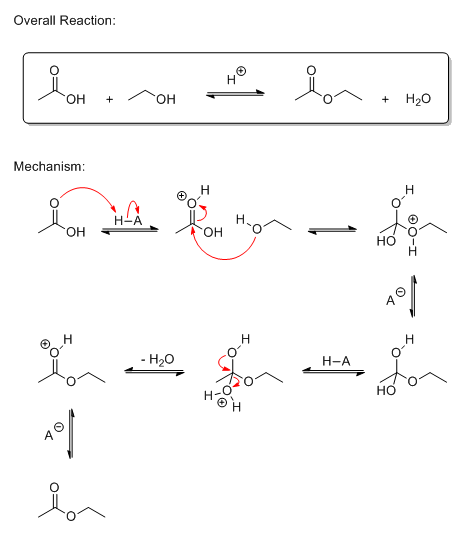
Answer to question 24:
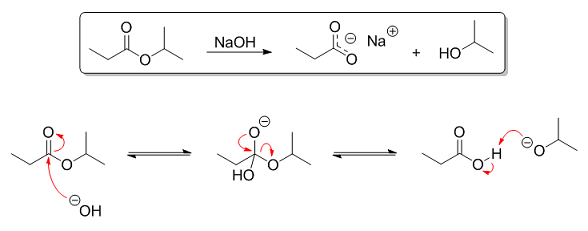
Answers to question 25 (SN2 reaction) that I would have accepted:
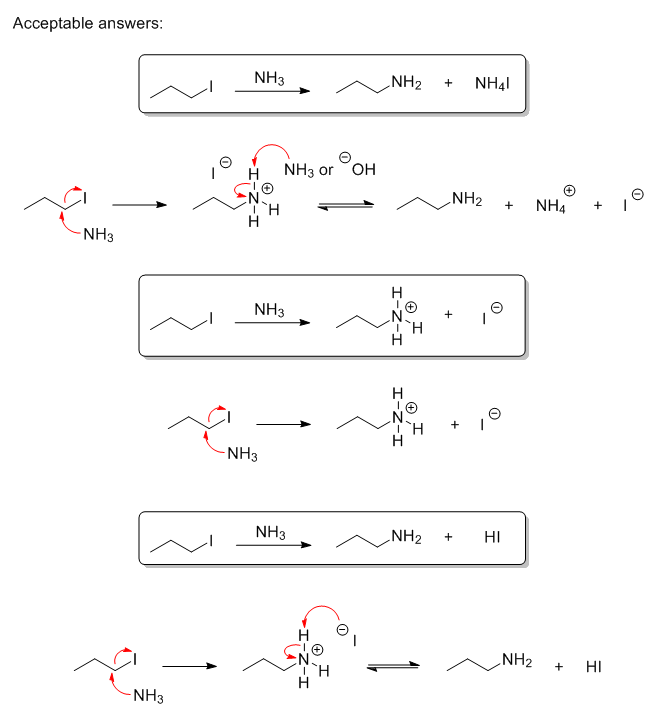
Answer to the first extra credit question (rearrangement via intramolecular substitution):

In-depth look at the N-chloroacetamide molecule from the second extra credit question:



[Edited on 12-10-2015 by Darkstar]
|
|
|
aga
Forum Drunkard
    
Posts: 7030
Registered: 25-3-2014
Member Is Offline
|
|
It feels like the principles covered are vital, so best to get them 100% clear before moving on.
There's no rush and i'd appreciate the errors pointing out as and when time allows.
|
|
|
blogfast25
International Hazard
    
Posts: 10562
Registered: 3-2-2008
Location: Neverland
Member Is Offline
Mood: No Mood
|
|
Aromatic substitutions:
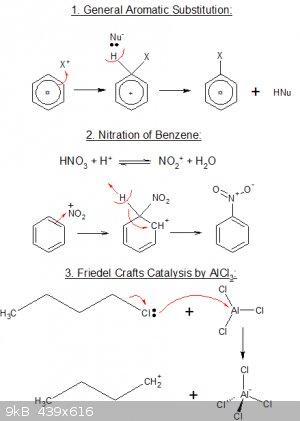
Substitutions on arenes require both an electrophilic (Lewis acid) and a nucleophilic (Lewis base) species.
Shown in the general case, the electrophile X<sup>+</sup> draws in one of the three resonant π MOs. The nucleophile
Nu<sup>-</sup> then snatches a proton from the ring, thus restoring the π MO.
Perhaps the best known aromatic substitution know is the nitration of benzene with concentrated nitric acid (2.) Concentrated (near 100 w%) nitric
acid has the property of auto-dissociating, acc. the equation shown, thus being able to supply both the electrophile and the
nucleophile. Here the reaction is shown with some resonance structures.
Case 3 we have already touched on much higher up, a Friedel-Crafts arene alkylation.
Here only the preliminary step of the formation of the Lewis base, the primary butyl carbocation is shown by reaction of chlorobutane with
AlCl<sub>3</sub>.
After the electrophilic attack on the arene on one of the three resonant π MOs, a proton is then extracted from the ring by the tetrachloroaluminate
and HCl evolves.
Multiple substitutions:
In each case the π ring is fully restored, making the substituted arene itself the potential subject of further substitutions on the 3 and 5 carbons,
see below e.g. the structure of trinitro benzene:
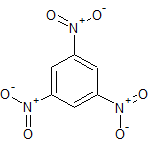
[Edited on 10-12-2015 by blogfast25]
|
|
|
aga
Forum Drunkard
    
Posts: 7030
Registered: 25-3-2014
Member Is Offline
|
|
Wooooooah Hoss !
Back to the Lone Pair on ammonia if one would be so kind.
Looking at the orbitals (which i think is confusing me a lot) N starts with
1s<sup>2</sup>2s<sup>2</sup>2p<sup>3</sup> (please say if that notation is correct or not).
Hybridised is it this :-
1s<sup>2</sup>2s<sup>1</sup>2p<sup>3</sup>3p<sup>1</sup> giving the valence orbitals
2p<sup>3</sup> and then a 3p<sup>1</sup> as that extra 'lone pair' (even though it is just one electron) ?
[Edited on 10-12-2015 by aga]
|
|
|
blogfast25
International Hazard
    
Posts: 10562
Registered: 3-2-2008
Location: Neverland
Member Is Offline
Mood: No Mood
|
|
Quote: Originally posted by aga  |
Looking at the orbitals (which i think is confusing me a lot) N starts with
1s<sup>2</sup>2s<sup>2</sup>2p<sup>3</sup> (please say if that notation is correct or not).
Hybridised is it this :-
1s<sup>2</sup>2s<sup>1</sup>2p<sup>3</sup>3p<sup>1</sup> giving the valence orbitals
2p<sup>3</sup> and then a 3p<sup>1</sup> as that extra 'lone pair' (even though it is just one electron) ?
|
Forget about the 1s<sup>2</sup>, they're inner electrons, not valence.
Re. the remaining 2s<sup>2</sup>2p<sup>3</sup>, that's 5 electrons in 4 AOs. These hybridise to four
2sp<sup>3</sup>-type hybrid AOs, one of which contains an electron pair, the three others contain only one unpaired
electron. The four sp<sup>3</sup> AOs point to the corners of a tetrahedron (like CH<sub>4</sub> . .
The three half-filled sp<sup>3</sup> can now σ-bond to whatever has a half-filled AO (H, C, X etc). So we end up with a structure like
the one top right in Darkstar's last post.
The one unbonded filled sp<sup>3</sup> AO is now available for dative bonding: sharing with an electropile or D-block
metal metal atom (complex formation).
That's what makes ammonia (or substituted ammonia like amines) a Lewis base (and Bronsted-Lowry bases).
[Edited on 10-12-2015 by blogfast25]
|
|
|
aga
Forum Drunkard
    
Posts: 7030
Registered: 25-3-2014
Member Is Offline
|
|
px, py, pz appear to be the orbital choices, yet there are 4 possible hybridised orbitals.
Would it not make more sense (geometrically) to have 4 electrons in a d orbital ?
I guess not, given the energy requirement to put them there.
Clearly i do not understand hybridisation at all.
|
|
|
blogfast25
International Hazard
    
Posts: 10562
Registered: 3-2-2008
Location: Neverland
Member Is Offline
Mood: No Mood
|
|
They are not choices. They are the orbitals dictated for n = 2 (Principal Quantum Number), by the SE and the Aufbau Pricinple.
d-orbitals lie at a higher level (at least here because the nearest one is 3d), that's correct.
For the Al hexa-aqua complexes we did invoke six 3sp<sup>3</sup>d<sup>2</sup> hybrid AOs, involving 4d. But 3p and 4d aren't
as far apart (energetically speaking) as 2p and 3d. In any case for N(+3) (ammonia etc) there's no need for higher than sp<sup>3</sup>
hybridisations.
Hybridisations are about minimising electrostatic repulsions between the AOs/MOs, this lowers potential energy of the molecule.
[Edited on 11-12-2015 by blogfast25]
|
|
|
aga
Forum Drunkard
    
Posts: 7030
Registered: 25-3-2014
Member Is Offline
|
|
I think this is where the problem was : the 2s and 2p energy diagrams were confused with orbitals somehow, despite there being only
three 2p boxes ...
The p orbitals can contain up to 6 electrons in one of 6 'lobes'.
N hybridisation in NH3 is from the 2s<sup>2</sup> 2p<sup>3</sup> ground state to a 2s<sup>1</sup>
2p<sup>4</sup> state, giving 4 outer orbitals, 1 for each hydrogen atom and one with a lone (single) electron in it looking for a nucleus
to snaffle.
This one, single, solitary electron is bewildering called a 'Lone Pair'.
Hopefully this is correct. If not, please stamp it flat immediately.
|
|
|
blogfast25
International Hazard
    
Posts: 10562
Registered: 3-2-2008
Location: Neverland
Member Is Offline
Mood: No Mood
|
|
Quote: Originally posted by aga  | I think this is where the problem was : the 2s and 2p energy diagrams were confused with orbitals somehow, despite there being only
three 2p boxes ...
The p orbitals can contain up to 6 electrons in one of 6 'lobes'.
N hybridisation in NH3 is from the 2s<sup>2</sup> 2p<sup>3</sup> ground state to a 2s<sup>1</sup>
2p<sup>4</sup> state, giving 4 outer orbitals, 1 for each hydrogen atom and one with a lone (single) electron in it looking for a nucleus
to snaffle.
This one, single, solitary electron is bewildering called a 'Lone Pair'.
Hopefully this is correct. If not, please stamp it flat immediately. |
You do seem to have a liiittle trouble counting the fingers on your hand! 
4 hybrid orbitals. A total of 5 electrons. "Mirror, mirror on the wall: how do we fit that in, all?"
Simples: three hybrids AO contain only 1 electron, one hybrid AO contains 2 electrons. Hence, in the latter case we
call it a lone (unbonded) electron pair. And 3 + 2 = 5 (in Roman numerals: III + II = V,  ) )
I think you're still grappling with dative bonding, so I'm gonna put up something to kill those gremlins. Watch this space!
[Edited on 11-12-2015 by blogfast25]
|
|
|
aga
Forum Drunkard
    
Posts: 7030
Registered: 25-3-2014
Member Is Offline
|
|
That's making more sense.
So how do you predict the hybridised configuration ?
|
|
|
blogfast25
International Hazard
    
Posts: 10562
Registered: 3-2-2008
Location: Neverland
Member Is Offline
Mood: No Mood
|
|
Refresher on dative bonding:
I'll take, merely as an example, the case of the adduct formed by the interaction of the Lewis base (nucleophile) ammonia and the Lewis acid
(electrophile), here a secondary propyl carbocation. (This is the second step in the reaction mechanism for the substitution of the halogen of
isopropyl halide by ammonia - formation of amine(s)). Not to scale:
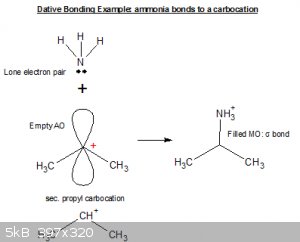
On the positively charged carbon atom there's an AO that is empty (zero electrons). That 'space' is filled up by ammonia 'donating'
its lone electron pair, which now becomes shared between the C and N nuclei. The latter is of course the definition of a simple σ
bond.
The positive charge of course doesn't disappear: it merely relocates to the N atom because it has 'lost' half of an electron pair, i.e. one electron
(thus 0 - (-1) = +1).
The resulting ion is called isopropyl ammonium cation.
[Edited on 11-12-2015 by blogfast25]
|
|
|
blogfast25
International Hazard
    
Posts: 10562
Registered: 3-2-2008
Location: Neverland
Member Is Offline
Mood: No Mood
|
|
Good question!
I could put up a complicated algorithm here but it's not really necessary.
1. Oxygen group: sp3 hybridisation. 4 hybrid orbitals. Two of these will contain lone electron pairs.
2. Nitrogen group: sp3 hybridisation. 4 hybrid orbitals. One of these will contain a lone electron pair.
3. Carbon group: sp3 hybridisation. 4 hybrid orbitals. None of these will contain a lone electron pair.
4. Boron group: sp2 hybridisation. 3 hybrid orbitals. None of these will contain a lone electron pair.
5. Beryllium: sp hybridisation. 2 hybrid orbitals. None of these will contain a pair electron pair. The rest of that group is too
electropositive to form hybrid orbitals: they lose their valence electrons in reactions.
[Edited on 11-12-2015 by blogfast25]
[Edited on 12-12-2015 by blogfast25]
|
|
|
aga
Forum Drunkard
    
Posts: 7030
Registered: 25-3-2014
Member Is Offline
|
|
Incredibly helpful !
All is clearer by a very large margin.
Just 1 question :-
You say "Oxygen group: sp3 hybridisation. 4 hybrid orbitals"
Is the "Oxygen group" All elements on the O column (#16) of the periodic table ?
|
|
|
| Pages:
1
..
26
27
28
29
30
..
33 |